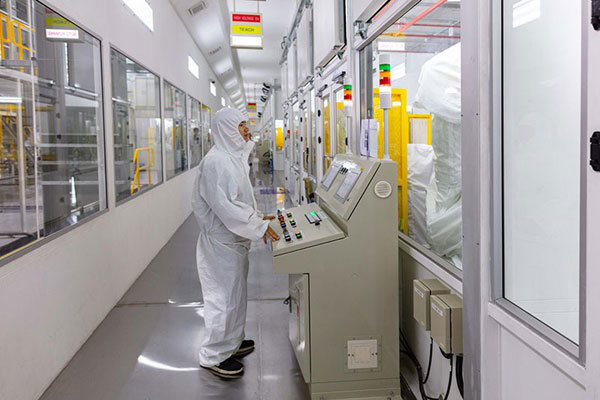Vietnam’s factories using more robots as production
Labor opportunities abound despite automation
 |
| A worker at Vinfast Automobile plant in Hai Phong City. — Photo hanoimoi.vn |
What are the highlights in the ongoing 5th science conference and international exhibition on automation (VCAA) in Hanoi?
The conference this time has two major activities – the business forum which was held in Hanoi on September 4-5 and a four-day international exhibition on automation from September 4-7.
Vietnamese and foreign scientists participated in the forum, with the main discussion topics energy saving, green energy and IT cities. At the international exhibition on automation, there are some 300 pavilions from more than 15 countries and territories. The forum is a good opportunity for experts from different countries to share ideas for the betterment of the products.
Is this a good occasion for the Vietnamese automation sector to share experience with foreign peers?
This time is a good occasion for Vietnamese scientists and enterprises to talk and share experiences with their foreign counterparts. This is a golden chance for Vietnamese scientists and enterprises to look for counterparts in the field of automation – a core in Industry 4.0, particularly AI.
What are your comments on the use of automation in Vietnam and in local enterprises?
Generally, at present the application of automation in Vietnam is still in the maiden stage, as most of our enterprises are small and medium and their profits are still modest. Of course, when automation is introduced, it requires enterprises to have high productivity and big products. To install an automation chain in a workshop, it costs quite a huge sum of money – billions of Vietnamese dong! That’s why for the time being, we should launch a communication campaign to raise awareness among enterprises on the importance of investing in automation if they want to raise productivity and gain high value added for their products. The enterprises must also have high quality human resources and modern infrastructure, as well as equipment.
Do you mean different enterprises should develop their own roadmaps for their automation plans?
I couldn't agree more. For financially strong enterprises they can start using automation in their workshops immediately. But for small and medium enterprises, they need a specific plan on how to start their automation. They could start the automation production phase by phase, from simple to difficult tasks. In other words, the enterprises should develop a detailed plan on what to do in each production phase.
In Vietnam nowadays, many enterprises have worked closely with scientists from research institutes, including the Ha Noi Technology University, the University of Transport and Communications and research institutes from many ministries. In real life, enterprises buy automatic production chains and invite scientists/experts to come to their enterprises to help operate production chains and then transfer their knowledge and skills to their technical staff so they can operate the production chains by themselves in the future.
Do you know what production chains have been automated most in Vietnam?
Right now, automation has been used widely in three areas – the beverage industry, information technology and spare parts, and the auto industry and motorbike manufacturing. Becamex – an industrial development corporation and Vinfast are two corporations that have pioneered in the use of industrial robots in their operation. The two corporations have introduced a total 300 industrial robots to their workshops.
VNS
 PhD Doctor Nguyen Quan, President of the Viet Nam Automation Association, talks to Hà Nội Mới (New Hà Nội) newspaper on the role of automation in Industry 4.0
PhD Doctor Nguyen Quan, President of the Viet Nam Automation Association, talks to Hà Nội Mới (New Hà Nội) newspaper on the role of automation in Industry 4.0